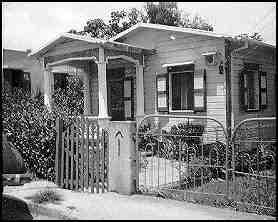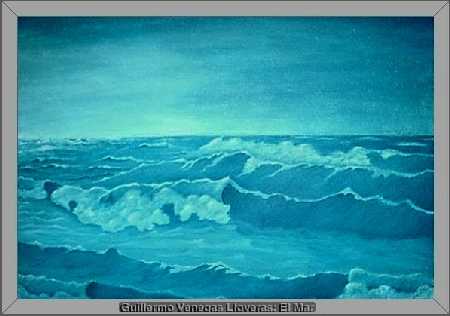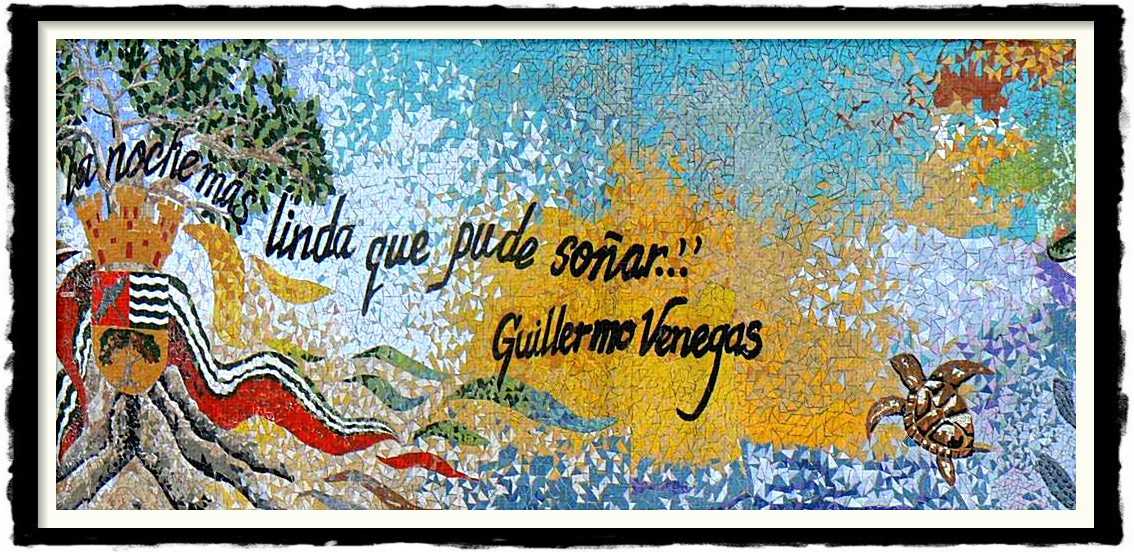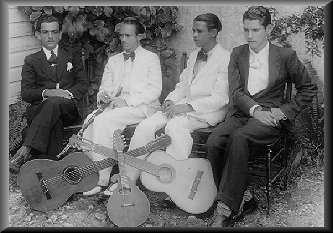
Chronology
Photos-Documents
Friends-Family
In 2008 the largest mosaic mural in Puerto Rico was inagurated at Quebradillas

Birth
Guillermo
Venegas Lloveras, William to many, was born in Quebradillas
on October 12, 1915. Quebradillas is a small town on the north coast of
Puerto Rico. Near the town is the beautiful beach of Guajataca, an inspiration
found in many of Guillermo's songs and poems. Guillermo was the second
child (of 5) of Rafael Venegas Oliviera and Maria Lloveras Soler. The Venegas
Lloveras household was typical middle class. Both mother and father were
hard working loving parents.
Parents
and Relatives
Rafael
was an orphan, whose both parents died on the same day of natural causes.
Rafael was a listener of fine music and an avid reader of literature,
history and philosophy. He also wrote poetry. This may account for
Guillermo's love of these very same things. Maria, the mother was the daughter
of Pablo Lloveras, who owned the town's drug store. Because Maria was ill
much of the time, you could say that Guillermo and his brothers and sisters
were also raised by an unmarried aunt named Ana Elisa Lloveras (Lela).
An uncle, Ernesto Lloveras was a businessman, owning first a cafeteria
and then a general goods store also lived in the Lloveras household. There
were no known musicians in the family tree of Guillermo. An aunt, Herminia,
had a piano and gave piano lessons, but never to Guillermo, as far as is
known. Guillermo had six siblings, Rafael (deceased), Olga, Carlos (deceased),
Pablo (deceased), Ernesto and Carmen Sara. Guillermo had six children,
Ana Maria, Aurea Iris (deceased), Guillermo, Maria, Rafael, Yeramar. He
maried five women, Aurea Hernandez (mother of Aurea Iris, Guillermo, Rafael
y Maria), Americo Ramos, Margarita Velasquez, (mother of Yeramar), Carmiña
Gonzales (mother of Ana Maria) and Lucy Chavez.
 School
School
Guillermo
only had formal, unsuccesful, schooling until he was 13 years old, when
he was ejected from school for good. It seems that he was never a good
student and was frequently in trouble with his teachers because he questioned
their knowledge of the facts with to much "energy". Because of his constant
reading of history, philosophy and poetry, music, it seems that he knew
too much for the level of teaching he was receiving and school bored him.
He never went back to school.
Juan
Heyliger (Juan Géliga)
Guillermo
was taught to play the guitar by Juan Heyliger (Juan Géliga), blacksmith,
cabinet maker and amateur guitar player at Quebradillas. Juan Geliga taught
Guillermo how to play the guitar at his blacksmith shop. Juan Geliga was
also an inspirer and a close lifetime friend of Guillermo. So, as some
have said, his conservatory was a blacksmith's shop.
Independence
Guillermo advocated for
the independence of Puerto Rico through his music, newspaper columns and
philosophical writing. He was friend and collaborator to the most important
and contemporary persons in that movement. His song Libertad
is dedicated to Pedro Albizu Campos (score). At the request of Gilberto
Concepcion de Gracia he composed the Independence Party hymn, Yo
quiero (mp3 - Trio Vegabajeño). Later he composed the danza
Juan
y Consuelo, dedicated to Juan Antonio Corretjer (mp3 - José Raúl
Ramirez). Dr. José Milton Soltero requested the song De
pie (mp3 - Pablo Elvira) as a counter to the movement of making english
the official language of Puerto Rico..That is why his song Tierra
Mia end with "en mis canciones siempre hay un grito de libertad (mp3 -
Guillermo Venegas)".
Music
Study - Intuition
Guillermo
started studying music by about age 10, as stated above, and never ended.
Guillermo studied music extensively on his own, becoming thoroughly familiar
with the works of many classical and popular music composers, as he had
a photographic memory for music. Perhaps what Pablo Casals meant by "without
study" was "without study at a conservatory" or the like. Guillermo himself
always said that he created music intuitively and that melodies would simply
"pop up" in his head without even thinking or trying to compose.

Mexico
By
1946 Guillermo was already an established musician well known as a guitarist,
singer and a composer in Puerto Rico and in latin America. Economically,
well that is another matter. This year Guillermo was awarded a special
scholarship to study music at Mexico. He was in Mexico a short time.
After a short stay at Mexico's Conservatorio Nacional de Musica, he quit
because, as he himself said, he knew more about music than the teachers.
He also commented that the teachers there were critical of his style.
Composition
Period
Guillermo
composed music during about 1925 to 1993, the year he died, Certainly few
composers have had such productive life. His last work was written
when hospitalized just prior to his death. This work was handed to a musician
friend, Mandy Visozo by Guillermo and is a homage to Spain.
The
Music
Guillermo
composed boleros, waltzes, tangos, marches, danzas, and his favorite, classical.
In his youth he dedicated his time to popular music and art songs, as composer,
guitar player and singer. Piano professor Margarita Van Rhyn, when he was
barely 22 years old, said his art songs were at the level of Schumann and
Schubert. In the later years of life the music of Guillermo was in general
(with some exceptions) classical in nature. Highlights of his later years
were the recordings that were made and two full house concerts concerts
of his music at Puerto Rico's major concert theaters, the Centro De Bellas
Artes and the theater of the University of Puerto Rico and a two hour television
special of his music produced by renown opera tenor Ricardo Ledesma.
Mi cabaña Listen to Mi Cabaña (MP3)
Mi Cabaña was among his first songs (the fist song was Ausencia (mp3 here sung by he author), recorded in ~1935 by Trio Armonico). Guillermo composed Mi cabaña when he was 12 years old. It was first recorded by William Venegas, a cousin, in ~1930. It became an instant hit and has since become one of the all time favorite songs in Puerto Rico popular music history. It has probably been recorded over 100 times. Up to this day many think that William Venegas the cousin singer and not William Venegas (Guillermo), the composer wrote the song.
Desde que te marchaste
(MP3)
and No me digan cobarde (MP3)
In
~1937 Guillermo Venegas, as a singer, recorded a record for RCA Victor
with two songs, Desde que te marchaste and No me digan cobarde. In english
the names of these songs are respectively "Since you left" and "Don't call
me coward" and were composed at age fifteen, when a girl friend, Dalila
Palmer, moved to another, far away place. These recordings are still
sold and heard, particularly in Colombia, where they have become "clasics"
of popular music and have been recorded many times. Millions of these recordings
have been sold but unfortunaltely almost never were licenses requested
from the author nor were royalty payments made. Here you can listen to
the original recordings of Desde
que te marchaste in MP3 and No
me digan cobarde in MP3 sung by Guillermo Venegas.
Los Panchos y Tu bien
lo sabes MP3
In
about 1946 The now legendary mexican Trio Los Panchos recorded the Guillermo
Venegas song Tu bien lo sabes. It was the first Los Panchos recording and
their first hit. In the 1950s and the 1980s Los Panchos recorded the song
again. Here
you may see a video of the song.
1952 contract with Peermusic
In 1952 composer Guillermo
Venegas signed a contract whereby he agreed to allow the largest music
publisher in the world, Peermusic, to administer several songs (which
ones is not clear, since Peermusic kept no record of what songs were given
and whatever documents Peermusic has are confusing. For example, a Peermusic
document talks about a plan to acquire Guillermo Venegas songs "without
the author suspecting". A result of this scheme (see
here) is that one or more songs that Guillermo Venegas did not write
wound up with the Venegas name attached to it. Another document, made at
the same time and same place where the "without the author suspecting document
was made, assigns many songs to Peermusic but the page
1 where the assignment is made is unsigned by the composer or by Peermusic,
as was required to make the assignment legal. The signed page, #2,
says nothing. Was page
1 changed to make the document appear that the composer assigned the
song? Nothing is certain but the combination of the two documents, including
the "without
the author suspecting" letter, raises a lot of questions. For most
of the "assigned" songs Peermusic has no score and least one song was totally
changed by Peer as a result of their not getting the song from Guillermo
Venegas but from another person, who did not know the songs and invented
a new one. At least another song, Llega la noche buena, was credited to
another composer, Edmundo Disdier, who was paid 70 dollars when over a
million dollars (at present value) should have been paid in royalries.
A total music publisher fiasco with the Guillermo Venegas songs. The result
of this contractual fiasco was that Peermusic never got any of the real
Venegas songs recorded in the many decades had the songs. For 21 songs,
per Peermusic record, the songs averaged less than a dollar of income per
year (no record of payments axist), all from recordings made before Peermusic
"acquired" the songs. This made Guillermo Venegas a skeptic as to music
music publishers and from there on he simply stored almost all of his new
compositions. For this reason, the vast majority of Guillermo Venegas's
has never seen the light of day. After Guillermo Venegas died, his
children sued Peermusic for their illegal activities. More information
about the case and the trial results and Judge José A. Fusté's
decision can be found
here.
Back
to Mexico with Génesis Video:
Génesis-Lucecita Génesis-Lucecita
(mp3)
In
1969, his song. Génesis (manuscript)
won the first Festival Mundial De La Musica Latina (World Festival
Of Latin Music), where it was sung by Lucecita Benitez, the great puertorican
singer. This prize won instant international recognition. To this date
this is considered by many as one of the more important cultural events
in the history of Puerto Rico. This festival was televised and broadcasted
live via satellite (an innovation then) to north and south america and
to europe, with an estimated audience of over 100 million. Guillermo Venegas
also participated in the first OTI Song competition of 1972 in Madrid,
Spain, finishing in fourth place with the song Por Ti, sung by Chucho Avellanet.
This competition also had an television audience of over 100 million persons.
After 1972, Guillermo Venegas did not participate in any other international
song competition. An interesting annectdote: After the Mexico triumph,
Guillermo Venegas was invited to Mexico. The president of Mexico requested
a visit from the composer and then asked what he could do for his guest.
Guillermo Venegas said he wanted to meet Agustin Lara, the great Mexican
composer of Granada, Maria bonita, Madrid, Noche de ronda and many other
well known classics. As arranged by the president, Guillermo Venegas was
taken to the home of Lara, where he was met by the singer Pedro
Vargas, an old friend. He was taken to a waiting room next to Lara's
bedroom but Agustin Lara was too ill to receive any visit on that eventful
day and Guillermo Venegas had to return to Puerto Rico. Shorly afterwards,
Mr. Lara, the composer who most influenced Guillermo Venegas, died. So,
Guillermo Venegas was one door away from meeting Agustin Lara, but destiny
denied the meeting.
Unfortunately the song Génesis is hardly heard anymore as explained here: GÉNESIS: THE DEATH OF A SONG.
Recordings
All
recordings dedicated solely to his music were done after he was 50 years
old, and were recorded in Puerto Rico by such artists as Pablo
Elvira (baritone), Alba Rosa Castro (piano), Ludvik Stonawski (piano)
and others. Fernando Montilla and Montilla Records were responsible for
the production of 4 of these records: Alba Rosa Castro, Ludvik Stonowski,
Carlos De Jesus and Guillermo himself as singer. See
recordings.
The
Poet - Author - Philosopher - Painter
Guillermo
was an accomplished poet, author, thinker and newspaper column writer.
He authored books such as Flor De Intermezzo (poems), Las Mil Cara
Del Amor (poems), La Luna De Puerto Rico, Ella y Yo (poems) Asi Hablara
Jesus (philosophical essay) and MARZO (philosophical novel). Guillermo
was also a painter. The painting below (El Mar) was among his firts, painted
about 1955 and given as a gift to aunt Lela (Ana Elisa Lloveras). This
painting hung at Lela's home until 1999.

Guillermo Venegas Lloveras died of cancer at age 77 on July 23, 1993. He was buried at Quebradillas in a burial ceremony attended by just a few friends. Apparently not many people were interested. As a farewell, the song "Adios Amigo Del Alma", which he had previously composed as a farewell song for a friend (Ramon Chavez, leftmost on Conjunto Aurea photograph below) was sung by Los Kintos.
The
Unknown, Controversial Composer
Guillermo,
at the time of his death was an almost unknown composer outside the musical
community in Puerto Rico and a circle of friends. The reasons for this
are many, interrelated and complex. Some of these reasons were, in the
view of this writer:
- He didn't care much for recognition, plaques, homages, appearances, etc.
- He did not promote his music or his person.
- His music was not published.
- He was ignorant about copyrigt law (written in english, a language he
did not understand), contracts and the business side of music. Almost everyone
took advantage of him because of this. Royalties were generally not paid
by record companies, and publishers.
- He hardly ever traveled outside of Puerto Rico. The opportunities were
many, but he almost always rejected them.
- He was too demanding and critical of those that performed his music.
- He always spoke his mind, regardless of the audience. For example, when
his song "Ese" was awarded second prize in the televised OTI festival in
Puerto Rico, he rejected the award handed to him by Marco Antonio Muñiz
and said: "I congratulate the winner, not for his ability, but for his
luck."
All in all, he was rebel and too controversial and this closed too many doors.
Greatness
The
world has produced many great composers. Always these composers lived and
worked in great cities and, or in counties of great traditions in classical
music compositions and performance. These composers almost always were
trained in music by prestigious instructors and academies. Guillermo was
not born in a large city and was not trained in any music school or conservatory.
Guillermo was a self-taught musician with an ability to create melodies
unlike any other composer before him. He was a thoroughly self educated
in music structure (harmony) and frequently used this knowledge in ways
that were really musically innovative. He said to this writer many times:
"I'am the only composer in history of which could be said that almost all
his melodies were very good." He also said: "No other composer has reached
the melody peak where only great composers reach, as frequently as I have."
History will be the judge.
Guillermo
Venegas Lloveras web page home
(click
here if left frame home link is not available)


